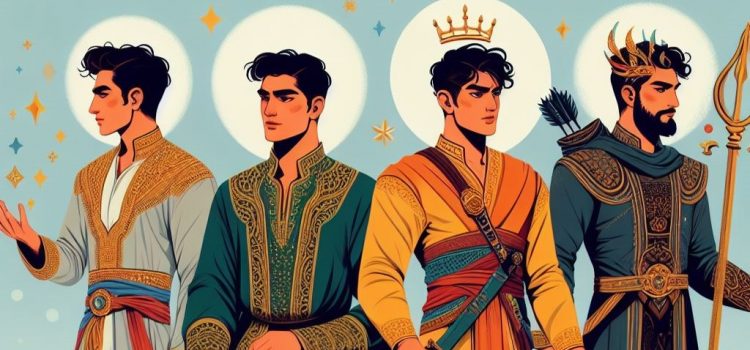
What are the 4 male archetypes defined by Carl Jung? How can we use these archetypes to understand the male psyche?
The 4 male archetypes commonly discussed include the King, Warrior, Magician, and Lover. Each archetype represents a part of the masculine psyche commonly found in men.
Here is what each archetype represents and how they are related to each other.
1. The King: Order and Judgment
The first of the 4 male archetypes is the King. This is the part of the psyche that maintains mental balance and stability; it’s a person’s internal voice of reason. Someone with a healthy King aspect can stay calm and confident, and make good decisions in stressful situations.
When properly developed, the King keeps the other personality aspects in check and unleashes them only when appropriate. For instance, when it’s time to stop thinking and start acting, the King allows a man to rein in his Magician aspect and bring his Warrior aspect to the fore.
(Shortform note: As the “ruler” of the psyche, the King aspect could be seen as representing executive functions: a person’s ability to make decisions and plans, then carry them out. The term executive functions brings to mind the image of a CEO running his company—or, in this case, a king ruling his kingdom.)
In addition to maintaining order and making rational decisions, the King is responsible for passing judgment on others. This means that a good King recognizes and rewards deserving individuals. He does this not just by physically seeing other people but also by striving to deeply understand them, really care about them, and recognize their true worth.
For example, a CEO with a poorly developed King aspect might praise and promote the workers who put in the most hours (a superficial judgment), while a CEO with a strong and healthy King aspect would promote the people who are best suited for leadership: the ones whom other people like and respect, who make good decisions, who are happy working for that company, and so on.
(Shortform note: The benefits of recognizing and rewarding people when they do well have been known for millennia. In the Analects, Confucius advises leaders to reward their best subordinates in order to keep them loyal and keep their morale up. However, this principle doesn’t just apply to leaders; showing sincere appreciation for family and friends is rewarding both for the person who gives a compliment and the person who receives it. In fact, some modern studies have shown that people respond to being “paid” a compliment in much the same way they respond to being paid with money.)
2. The Warrior: Action, Discipline, and Devotion
Whereas the King is the leader of a man’s psyche, the Warrior is the part that gets things done. Phrased differently, the King gives commands and the Warrior carries them out.
However, the Warrior aspect is about much more than just turning decisions into actions. The Warrior—like the idealized knights in King Arthur’s legends—is a symbol of discipline, strength, skill, and loyalty.
When a man has a well developed Warrior aspect, his first concerns are always self-discipline and self-control. This is because the greatest Warriors are those who master their own minds; by doing so, they develop the will, focus, and courage to accomplish incredible things. Therefore, someone with a strong Warrior aspect can act quickly and decisively, without getting distracted by stray thoughts or feelings.
Although he’s not a warrior in the usual sense, the legend of the Buddha gives an excellent example of this aspect: The Buddha achieved such perfect mastery over himself that he was able to defeat an evil god named Mara. This god had great powers of illusion and temptation, but the Buddha maintained control of his mind, and so he wasn’t affected. Mara eventually realized that he couldn’t trick the Buddha, and he was forced to give up.
(Shortform note: This example is especially apt for a discussion of healthy masculinity because the Buddha defeated Mara without ever attacking him. As we’ll discuss shortly, someone who’s too quick to use force—or, worse, who enjoys doing so—is being influenced by an imbalanced Warrior aspect.)
The Warrior’s discipline also drives a man to keep honing his skills so that he’s better able to accomplish his tasks and achieve his goals, whatever those might be. For instance, a musician who practices every single day is exercising a Warrior’s discipline; so is an office worker who constantly looks for ways to boost his productivity and the quality of his work.
Recall that the Warrior is also responsible for loyalty. This means loyalty to something larger and more important than any individual, such as a country, a deity, or a mission. For instance, an environmental activist and a religious leader are both people who have pledged their loyalty to a greater cause.
Crucially, a man with the Warrior’s loyalty values his cause more highly than he values any person, including himself. As a result, he’s willing to endure great hardships and countless defeats in pursuit of his goals. With that said, a mature Warrior aspect also helps him to think rationally—to accurately assess his own abilities and decide how he could do the most good, rather than uselessly throwing himself against impossible odds.
Finally, someone with a mature Warrior aspect has recognized and accepted that he’ll die someday. Rather than scaring or depressing him, this awareness of his own death drives him to make the most of whatever time he has. As such, he fully experiences and appreciates every moment that he lives, and approaches each task as if it’s the last and most important thing he’ll ever do. To sum it up with a common saying, the Warrior lives each day as though it were his last.
| Stoicism and the Warrior Aspect This description of the Warrior aspect is a near-perfect echo of Stoicism. Stoicism is an ancient school of philosophy that teaches people they can live good, fulfilling lives through the use of logic and rationality. Discipline and self-control are central themes in Stoicism. A significant part of Marcus Aurelius’s Meditations, one of Stoicism’s fundamental books, describes gaining control over oneself by recognizing that pleasure isn’t beneficial and pain isn’t harmful. This is important because people who don’t crave pleasure or fear pain can spend their lives tirelessly working to help others and ruthlessly improving themselves so they’re better able to do so. According to Aurelius, working for the common good is the only worthwhile purpose in life—it’s the ideal cause for a Warrior to pledge his loyalty to. Finally, Aurelius taught that mortality should be motivating rather than frightening. To help people overcome their fear of death, Aurelius adds that death is part of the natural order of things, and nature couldn’t have evolved in that way if death were harmful. He also urges people to examine exactly what they’re afraid of losing when they die; since death only takes away their sense of self, and Stoicism is an inherently selfless philosophy, a Stoic should conclude that nothing of value will be lost. |
3. The Magician: Knowledge and Wisdom
The Magician aspect is, in a way, the polar opposite of the Warrior. The Magician is the deeply intellectual part of the psyche: It studies, learns, and seeks to understand obscure and complex subjects. This aspect is called the Magician because it grants insights and abilities that can seem supernatural—for instance, a skilled computer programmer could design software tools that boost his productivity to levels that other people would think are impossible.
The Magician’s drive for understanding also includes understanding people, including the person whose psyche it’s a part of. It’s the part of the mind that analyzes people’s behavior and tries to discern their real intentions and motivations. As such, the Magician is a person’s internal lie detector and moral compass.
(Shortform note: Picking up on someone’s intentions and motivations is often a matter of reading their body language and other contextual clues. Most people do this naturally to some extent, but it’s also a skill that can be learned and honed. In The Dictionary of Body Language, former FBI agent Joe Navarro describes numerous nonverbal cues that people give, and how to interpret them. For example, rubbing one’s shoulder is a self-soothing behavior and therefore might indicate nervousness. The next step is to figure out why that person is nervous—in Navarro’s case, he might use various other cues to decide whether they’re just nervous about talking to an FBI agent, or if they’re nervous because they’re lying to him.)
Finally, the Magician empowers someone to act as a healer and problem solver, like the wise men of ancient cultures. The Magician’s knowledge makes it the aspect that’s best suited for treating illnesses and injuries, as well as giving advice in difficult situations. Again, this includes helping the one whose mind it’s a part of. For example, suppose someone hurts his ankle: His inner Warrior might encourage him to push through the pain, but his Magician aspect will wisely advise him to rest and heal.
| Empower the Magician by Learning How to Learn Since the Magician aspect’s abilities come from learning, people can empower their inner Magician by learning how to learn effectively. For instance, someone who wants to become a doctor (a “professional magician,” so to speak) needs to learn an enormous amount of information in medical school, and that would be difficult without an effective study strategy. In Limitless, educator and “brain coach” Jim Kwik presents a learning model that he says will remove the limits on a person’s ability to learn. The Limitless model has three components: 1. Mindframe: The learner must truly believe in their own limitless potential and must be open-minded about new information. In other words, they must know that they’re able to learn, and they must be ready to learn. 2. Drive: The learner must find ways to motivate themselves to learn about whatever topic they’re studying. This is crucial because even someone who knows they can learn anything still won’t learn about subjects they’re not interested in. 3. Techniques: The learner uses specific practices and strategies to quickly absorb and retain new information. For example, Kwik suggests that people try visualizing what they’re learning about, instead of just trying to memorize the words on a page. |
4. The Lover: Desire, Passion, and Joy
All of the previous aspects were concerned with various kinds of control: control over oneself, control over one’s surroundings, or both. The Lover is the opposite—it’s the part of the psyche that wants to unrestrainedly enjoy all the pleasures that life has to offer.
This aspect is also unique because it’s motivated by emotions, rather than by intellect. The Lover fuels a person’s feelings of vigor, passion, and joy. It also drives him to fulfill his various needs and desires; this includes biological urges like food and sex, but also less tangible cravings such as joy, love, and a sense of purpose. Therefore, someone under the Lover’s influence wants to explore and experience as much as he can because he’s looking for ways to satisfy those desires.
(Shortform note: In neurological terms, many of the Lover’s functions are explained by the chemical dopamine. In The Molecule of More, the authors explain that dopamine motivates people to seek out new experiences and to pursue the things they want. A person’s brain releases dopamine when they encounter something new or unexpected, or when they make progress toward a goal. That dopamine release is pleasurable, so people naturally want to do things that cause it. A few examples are eating a good meal, pursuing a new relationship, and working toward a promotion.)
The Lover is also highly empathetic, meaning that someone with a strong Lover aspect instinctively understands other people’s feelings and shares them. This can be very painful, but he finds joy even in the pain; to the Lover, all experiences are things to enjoy and celebrate. (Shortform note: It’s a common misconception that people can spur their empathy by imagining themselves in someone else’s position. However, that tactic engages the intellect (the Magician) rather than the emotions (the Lover) and may cause people to bring their own assumptions and biases into the situation. In Atlas of the Heart, Brené Brown explains that empathy simply means understanding another person’s feelings and accepting those feelings for what they are.)







FWIW: These four archetypes were developed by Robert Moore and Douglas Gillette from Jung’s double quaternio archetypes in their book “King, Warrior, Magician, Lover.”